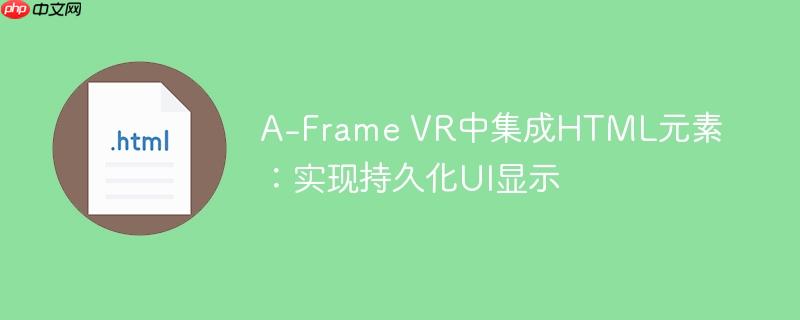
在使用a-frame构建沉浸式vr体验时,开发者常常会遇到一个挑战:标准的html元素(如按钮、文本框等)在进入vr模式后会从视图中消失。这是因为a-frame的vr模式会接管整个渲染上下文,将3d场景全屏显示,而浏览器中的常规2d html/css层则被隐藏或置于其下方。这对于需要提供持久化用户界面(如导航按钮、信息面板、退出按钮)的vr应用来说,是一个显著的障碍。尽管在某些特定平台(如ios)上可能偶尔出现html元素意外显示的情况,但这并非可靠的跨平台解决方案。
为了在A-Frame的3D场景中渲染和交互HTML元素,我们可以借助第三方组件——aframe-htmlembed-component。这个组件允许开发者将任意HTML和CSS内容作为纹理嵌入到A-Frame的实体(a-entity)上,使其成为3D场景的一部分,从而在VR模式下也能正常显示和交互。
首先,在你的HTML文件的<head>部分引入A-Frame库以及aframe-htmlembed-component和aframe-look-at-component(用于将UI元素固定到相机视角)。
<!DOCTYPE html>
<html>
<head>
<script src="https://aframe.io/releases/1.3.0/aframe.min.js"></script>
<!-- aframe-look-at-component 用于将实体始终朝向相机 -->
<script src="https://unpkg.com/aframe-look-at-component@0.8.0/dist/aframe-look-at-component.min.js"></script>
<!-- aframe-htmlembed-component 用于嵌入HTML内容 -->
<script src="https://supereggbert.github.io/aframe-htmlembed-component/dist/build.js"></script>
<style>
/* 你可以在这里定义按钮或其他HTML元素的样式 */
button {
padding: 10px 20px;
background-color: #f44336;
color: white;
border: none;
border-radius: 5px;
font-size: 16px;
cursor: pointer;
box-shadow: 0 4px 8px rgba(0, 0, 0, 0.2);
transition: background-color 0.3s ease;
}
button:hover {
background-color: #d32f2f;
}
</style>
</head>
<body>
<a-scene>
<!-- 场景中的其他3D元素 -->
<a-box position="-1 0.5 -3" rotation="0 45 0" color="#4CC3D9"></a-box>
<a-sphere position="0 1.25 -5" radius="1.25" color="#EF2D5E"></a-sphere>
<a-cylinder position="1 0.75 -3" radius="0.5" height="1.5" color="#FFC65D"></a-cylinder>
<a-plane position="0 0 -4" rotation="-90 0 0" width="4" height="4" color="#7BC8A4"></a-plane>
<a-sky color="#ECECEC"></a-sky>
<!-- 嵌入HTML按钮的实体 -->
<a-entity position="0 1.6 -1" htmlembed look-at="[camera]">
<button id="leaveButton" onclick="console.log('Leave button is clicked'); alert('You clicked the leave button!');">离开VR</button>
</a-entity>
<!-- 相机设置 -->
<a-entity position="0 0 0" wasd-controls>
<a-entity camera position="0 2 0" look-controls cursor="rayOrigin: mouse"></a-entity>
</a-entity>
</a-scene>
</body>
</html>在你的A-Frame场景中,创建一个a-entity,并为其添加htmlembed组件。所有你想在3D场景中显示的HTML内容(包括CSS样式和JavaScript交互)都将作为这个a-entity的子元素放置。
<a-entity position="0 1.6 -1" htmlembed look-at="[camera]">
<button id="leaveButton" onclick="console.log('Leave button is clicked'); alert('You clicked the leave button!');">离开VR</button>
</a-entity>在a-entity内部,你可以像编写普通HTML一样添加按钮、文本、图片等。这些元素将遵循你定义的CSS样式,并且可以响应JavaScript事件(如onclick)。在上面的示例中,我们添加了一个简单的“离开VR”按钮,并为其绑定了一个onclick事件,当用户点击时会在控制台输出信息并弹出一个提示框。
立即学习“前端免费学习笔记(深入)”;
你可以在HTML文件的<head>部分定义<style>标签,或者链接外部CSS文件来样式化嵌入的HTML元素。aframe-htmlembed-component会正确地应用这些样式。
aframe-htmlembed-component为A-Frame开发者提供了一个将传统Web内容无缝集成到VR体验中的强大工具。通过它,我们可以轻松地在3D场景中显示和交互HTML元素,解决VR模式下UI消失的问题。结合aframe-look-at-component,我们可以创建出始终面向用户的持久化UI,显著提升VR应用的可用性和用户体验。在实际开发中,开发者应根据项目需求权衡性能与功能,选择最适合的UI实现方式。
以上就是A-Frame VR中集成HTML元素:实现持久化UI显示的详细内容,更多请关注php中文网其它相关文章!

HTML怎么学习?HTML怎么入门?HTML在哪学?HTML怎么学才快?不用担心,这里为大家提供了HTML速学教程(入门课程),有需要的小伙伴保存下载就能学习啦!

Copyright 2014-2025 https://www.php.cn/ All Rights Reserved | php.cn | 湘ICP备2023035733号